Choosing a Gaming CPU at 1440p: Adding in Haswell
by Ian Cutress on June 4, 2013 10:00 AM ESTCivilization V
A game that has plagued my testing over the past twelve months is Civilization V. Being on the older 12.3 Catalyst drivers were somewhat of a nightmare, giving no scaling, and as a result I dropped it from my test suite after only a couple of reviews. With the later drivers used for this review, the situation has improved but only slightly, as you will see below. Civilization V seems to run into a scaling bottleneck very early on, and any additional GPU allocation only causes worse performance.
Our Civilization V testing uses Ryan’s GPU benchmark test all wrapped up in a neat batch file. We test at 1440p, and report the average frame rate of a 5 minute test.
One 7970

Civilization V is the first game where we see a gap when comparing processor families. A big part of what makes Civ5 perform at the best rates seems to be PCIe 3.0, followed by CPU performance – our PCIe 2.0 Intel processors are a little behind the PCIe 3.0 models. By virtue of not having a PCIe 3.0 AMD motherboard in for testing, the bad rap falls on AMD until PCIe 3.0 becomes part of their main game.
Two 7970s
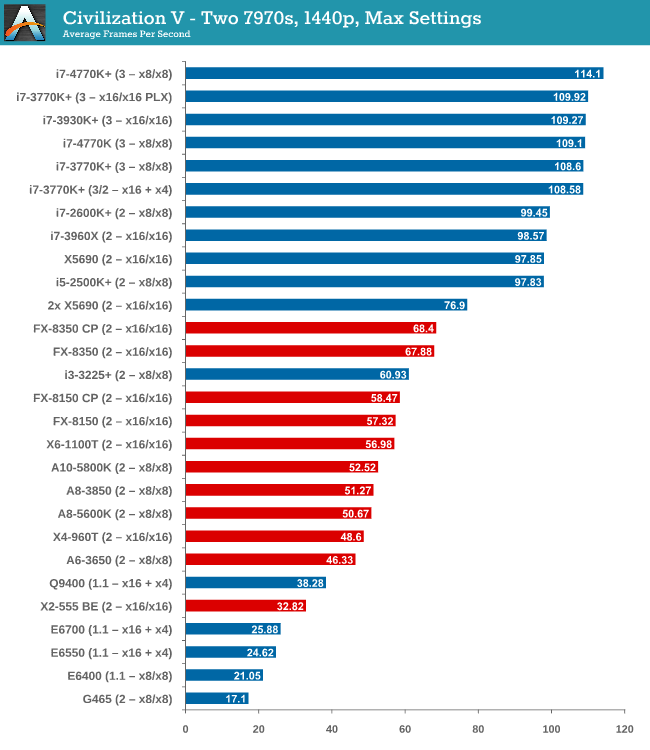
The power of PCIe 3.0 is more apparent with two 7970 GPUs, however it is worth noting that only processors such as the i5-2500K and above have actually improved their performance with the second GPU. Everything else stays relatively similar.
Three 7970s
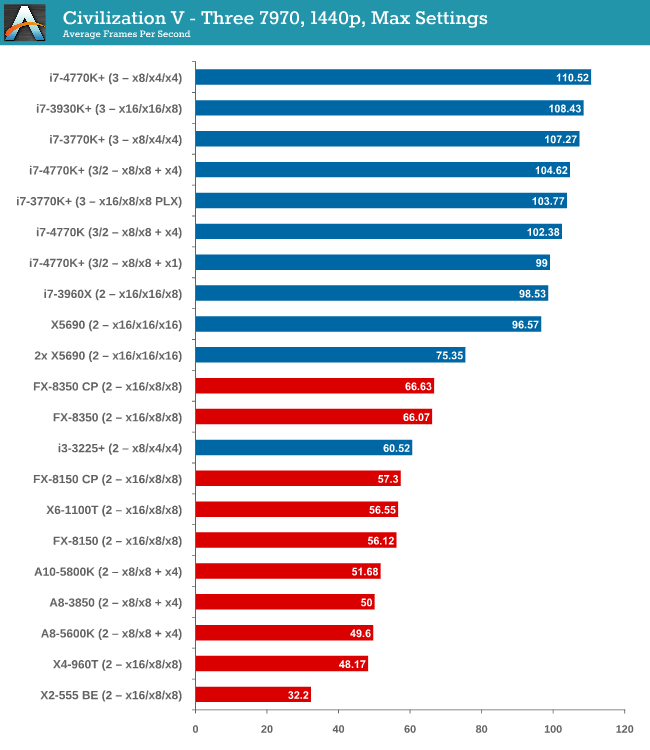
More cores and PCIe 3.0 are winners here, but no GPU configuration has scaled above two GPUs.
Four 7970s
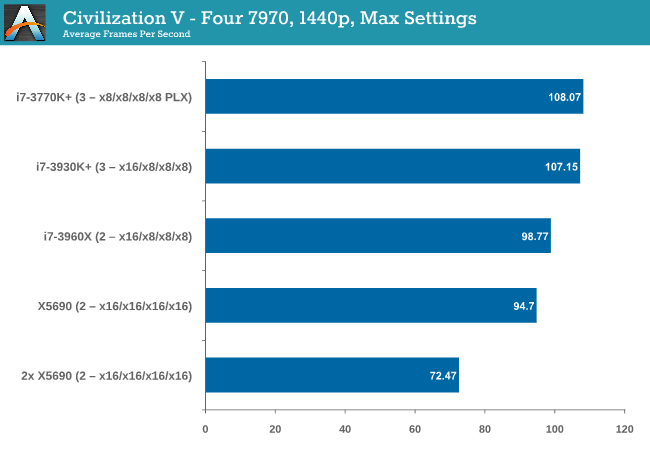
Again, no scaling.
One 580
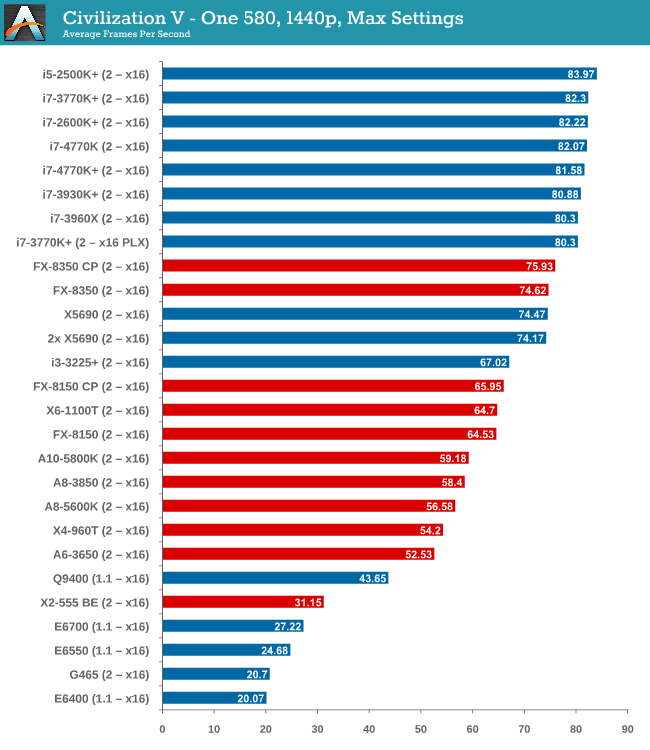
While the top end Intel processors again take the lead, an interesting point is that now we have all PCIe 2.0 values for comparison, the non-hyper threaded 2500K takes the top spot, 10% higher than the FX-8350.
Two 580s
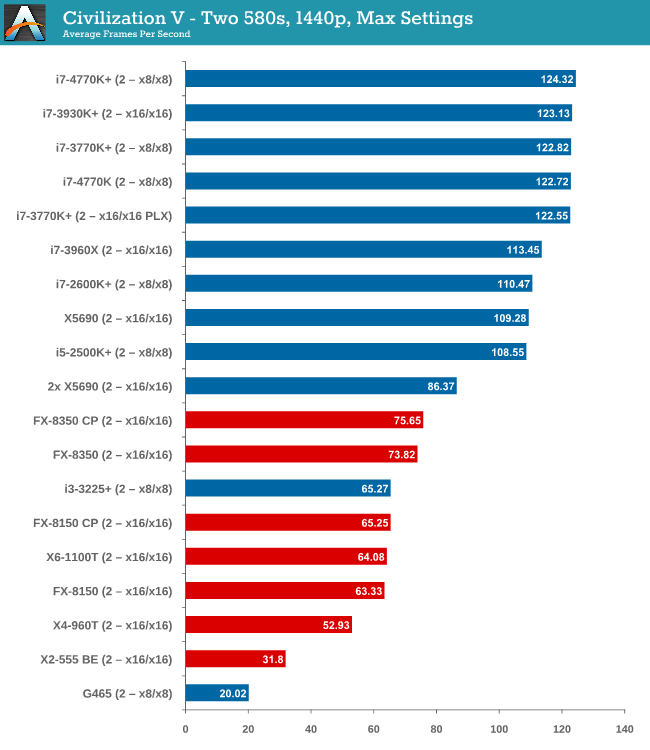
We have another Intel/AMD split, by virtue of the fact that none of the AMD processors scaled above the first GPU. On the Intel side, you need at least an i5-2500K to see scaling, similar to what we saw with the 7970s.
Civilization V conclusion
Intel processors are the clear winner here, though not one stands out over the other. Having PCIe 3.0 seems to be the positive point for Civilization V, but in most cases scaling is still out of the window unless you have a monster machine under your belt.










116 Comments
View All Comments
IanCutress - Tuesday, June 4, 2013 - link
Hi Ternie,To answer your questions:
(1) Unfortunately for a lot of users, even DIY not just system integrators, they leave the motherboard untouched (even at default memory, not XMP). So choosing that motherboard with MCT might make a difference in performance. Motherboards without MCT are also different between themselves, depending on how quickly they respond to CPU loading and ramp up the speed, and then if they push it back down to idle immediately in a low period or keep the high turbo for a few seconds in case the CPU loading kicks back in.
2) This is a typo - I was adding too many + CPU results at the same time and got carried away.
3) While people have requested more 'modern' games, there are a couple of issues. If I release something that has just come out, the older drivers I have to use for consistency will either perform poorly or not scale (case in point, Sleeping Dogs on Catalyst 12.3). If I am then locked into those drivers for a year, users will complain that this review uses old drivers that don't have the latest performance increases (such as 8% a month for new titles not optimized) and that my FPS numbers are unbalanced. That being said, I am looking at what to do for 2014 and games - it has been suggested that I put in Bioshock Infinite and Tomb Raider, perhaps cut one or two. If there are any suggestions, please email me with thoughts. I still have to keep the benchmarks regular and have to run without attention (timedemos with AI are great), otherwise other reviews will end up being neglected. Doing this sort of testing could easily be a full time job, which in my case should be on motherboards and this was something extra I thought would be a good exercise.
Michaelangel007 - Tuesday, June 4, 2013 - link
It is sad to poor journalism in the form of excuses in an otherwise excellent article. :-/1. Any review sites that make excuses for why they ignore FCAT just highlights that they don't _really_ understand the importance of _accurate_ frame stats.
2. Us hardcore games can _easily_ tell the difference betwen 60 Hz and 30 Hz. I bought a Titan to play games at 1080p @ 100+ Hz on the Asus VG248QE using nVidia's LightBoost to eliminate ghosting. You do your readers a dis-service by again not understand the issue.
3. Focusing on 1440 is largely useless as it means people can't directly compare how their Real-World (tm) system compares to the benchmarks.
4. If your benchmarks are not _exactly_ reproducible across multiple systems you are doing it wrong. Name & Shame games that don't allow gamers to run benchmarks. Use "standard" cut-scenes for _consistency_.
It is sad to see the quality of a "tech" article gloss and trivial important details.
AssBall - Tuesday, June 4, 2013 - link
Judging by your excellent command of English, I don't think you could identify a decent technical article if it slapped you upside the head and banged your sister.Razorbak86 - Tuesday, June 4, 2013 - link
LOL. I have to agree. :)Michaelangel007 - Wednesday, June 5, 2013 - link
There is a reason Tom's Hardware, Hard OCP, guru3d, etc. uses FCAT.I feel sad that you and AnandTech tech writers are to stupid to understand the importance of high frame rates (100 Hz vs 60 Hz vs 30 Hz), frame time variance, 99 percentile, proper CPU-GPU load balancing, and micro stuttering. One of these days when you learn how to spell 'ad hominem' you might actually have something _constructive_ to add to the discussion. Shooting the messenger instead of focusing on the message shows you are still a immature little shit that doesn't know anything about GPUs.
Ignoring the issue (no matter how badly communicated) doesn't make it go away.
What are _you_ doing to help raise awareness about sloppy journalism?
DaveninCali - Tuesday, June 4, 2013 - link
Why doesn't this long article include AMD's latest APU, the Richland 6800K? Heck you can even buy it now on Newegg.ninjaquick - Tuesday, June 4, 2013 - link
The data collected in this article is likely a week or two old. Richland was not available at that time. It takes an extremely long time to do this kind of testing.DaveninCali - Tuesday, June 4, 2013 - link
Richland was launched today. Haswell was launched two days ago. Neither CPU was available two weeks ago. It all depends on review units being released to review websites. Either Richland was left out because it wasn't different enough from Trinity to matter or AMD did not hand out review units.majorleague - Wednesday, June 5, 2013 - link
Here is a youtube link showing 3dmark11 and windows index rating for the 4770k 3.5ghz Haswell. Not overclocked.Youtube link:
http://www.youtube.com/watch?v=k7Yo2A__1Xw
Chicken76 - Tuesday, June 4, 2013 - link
Ian, in the table on page 2 there's a mistake: the Phenom II X4 960T has a stock speed of 3 GHz (you listed 3.2 GHz) and it does turbo up to 3.4 GHz.